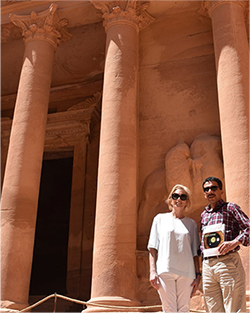Download PDF

It’s not surprising that ophthalmologists make good photographers. Howie Schatz, once a retina specialist in San Francisco, moved to New York City and crafted a career in photography. Howie’s extravagant photos make striking coffee-table books, as demonstrated by an American Photo Book of the Year Award in 2015. Jeff Maltzman, my friend on Facebook (and a real-life friend, too), posts extraordinary photographs taken near his home in Arizona. My ophthalmology colleague Talal Hrout is also a photographer, posting striking photos on Facebook and Instagram of landscapes near his home in Amman, Jordan.

POST YOUR PHOTO WITH EYENET. I posted this photo on Facebook while visiting Petra with my family and our colleague Talal Hrout (pictured, holding February’s EyeNet). When you’re traveling to SOE, PAAO, ESCRS, or even just for fun, post your photo with EyeNet. (And be sure to tag the Academy!) Last but not least, EyeNet makes great reading on the plane.
Talal, Jeff, and I formed a kinship through the allure of the desert. I first got to know Talal as a colleague when he came to our institution for an International Council of Ophthalmology fellowship; he became a friend after he took a quick trip to Yellowstone National Park and rhapsodized about its beauty. I grew up in the high plains of western Wyoming, and I resonate with people like Talal who feel its magic. Last month, my husband, son, and I visited Talal and his family in Jordan, and he showed us some of his own places of beauty, the locations he captures in his photographs.
Like photographs, clinical knowledge, science, and innovative ideas are meant to be shared. That’s why EyeNet Magazine is so important. It is an exceptional monthly compilation of clinical pearls, shared ophthalmic experiences, fresh ideas, medical news, reporting on innovative ideas, and summaries of important journal articles—and it is widely shared across the county and around the world. Of the 22,000 printed copies, 550 are mailed to international subscribers. And when the digital version of each month’s EyeNet is posted online, we email the link to 28,000 ophthalmologists of whom 8,000 are international members, a number that has been increasing.
Because EyeNet’s international readership is growing, the editorial staff is responding by including more international perspectives on clinical issues. For example, one of our experts for the March 2017 feature article on corneal cross-linking was Alaa ElDanasoury, a cornea specialist at Magrabi Eye & Ear Hospital in Saudi Arabia. While the Avedro KXL system received FDA approval in the United States in 2016, Alaa has been performing cross-linking procedures since 2005 and has a depth of experience that is valuable to our readers. The October feature article will be on IOLs around the world, and we are eliciting input from ophthalmologists in many regions.
Most of EyeNet’s international readers, and many in the United States, read the digital version, which has some great features. It allows the editors to add sidebar content, extra pictures, and links to video interviews. And it lets you—the readers—add your opinions and ideas in a comment area at the end of each article. Your comments are encouraged and appreciated! In fact, last month I invited an ophthalmologist who noted a new approach to glaucoma monitoring to publish his comment as a Letter to the Editor. As colleagues, we listen and we learn—after all, we practice and teach ophthalmology as a community.
But the print version of the magazine still has a place in my heart. It provides a relaxed reading experience, and it lets us have some fun (see photo, above). Whether you receive the print version of EyeNet by mail or pick up a copy at a meeting (SOE, PAAO, and ESCRS are coming up!), take EyeNet with you when you travel, and post your photo with EyeNet on Facebook or Twitter, tagging the Academy. It’s even better if the photo is taken in a desert.